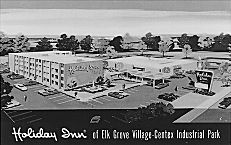| Entries |
| E |
|
Elk Grove Village, IL
|
 Cook and Lake Counties, 20 miles NW of the Loop. Elk Grove Village differs from many other suburban towns in that it did not emerge as a nineteenth-century market town, or around a railroad depot; indeed, it did not come into existence as a center of settlement until around 1940, roughly at the place where Touhy Avenue intersects with route 53.
Cook and Lake Counties, 20 miles NW of the Loop. Elk Grove Village differs from many other suburban towns in that it did not emerge as a nineteenth-century market town, or around a railroad depot; indeed, it did not come into existence as a center of settlement until around 1940, roughly at the place where Touhy Avenue intersects with route 53.
This was in the southeastern corner of the old Elk Grove township, which took its name from the huge grove that is now the Ned Brown Forest Preserve. Bounded on the west by Salt Creek, and on the east by the line of the present Arlington Heights Road, this forested area attracted not only Potawatomi hunters, but also, from the mid-1830s onwards, Yankee settlers. The open prairie areas often tended to be marshy, but the early Yankee farmers were joined in the late 1840s by Germans, and together they eventually drained much of the area round the future site of Elk Grove Village.
No railroad traversed this part of the country, and it remained very rural right down to the Second World War; indeed, it is only on the map of 1941 that we begin to discern the development of a little town. At that time the future O'Hare Airport, a mile or so to the southeast, was beginning to emerge as a center for the manufacture of Douglas transport aircraft; eventually it would become the major hub of United Airlines, which would make its headquarters in Elk Grove Village.

|
The Northwest Tollway also clipped off the northern section of the old grove. But in general the Elk Grove Forest Preserve, established in 1924, succeeded not only in resisting such encroachments, but even in recovering land previously lost. By 1994 the great grove had largely recovered its historic outline. By 2000 Elk Grove Village had reached the limits of territorial expansion, with 34,727 inhabitants.
| Elk Grove Village, IL (inc. 1956) | |||||
| Year |
Total
(and by category) |
Foreign Born | Native with foreign parentage | Males per 100 females | |
| 1960 | 6,608 | 2.3% | 16.9% | 98 | |
| 6,606 | White (100.0%) | ||||
| 2 | Other races (0.0%) | ||||
| 1990 | 33,429 | 9.4% | — | 97 | |
| 30,644 | White (91.7%) | ||||
| 197 | Black (0.6%) | ||||
| 27 | American Indian (0.1%) | ||||
| 2,292 | Asian/Pacific Islander (6.9%) | ||||
| 269 | Other race (0.8%) | ||||
| 1,194 | Hispanic Origin* (3.6%) | ||||
| 2000 | 34,727 | 14.3% | — | 95 | |
| 29,874 | White alone (86.0%) | ||||
| 490 | Black or African American alone (1.4%) | ||||
| 33 | American Indian and Alaska Native alone (0.1%) | ||||
| 3,051 | Asian alone (8.8%) | ||||
| 15 | Native Hawaiian and Other Pacific Islander alone (0.0%) | ||||
| 797 | Some other race alone (2.3%) | ||||
| 467 | Two or more races (1.3%) | ||||
| 2,165 | Hispanic or Latino* (6.2%) | ||||
The Encyclopedia of Chicago © 2004 The Newberry Library. All Rights Reserved. Portions are copyrighted by other institutions and individuals. Additional information on copyright and permissions.